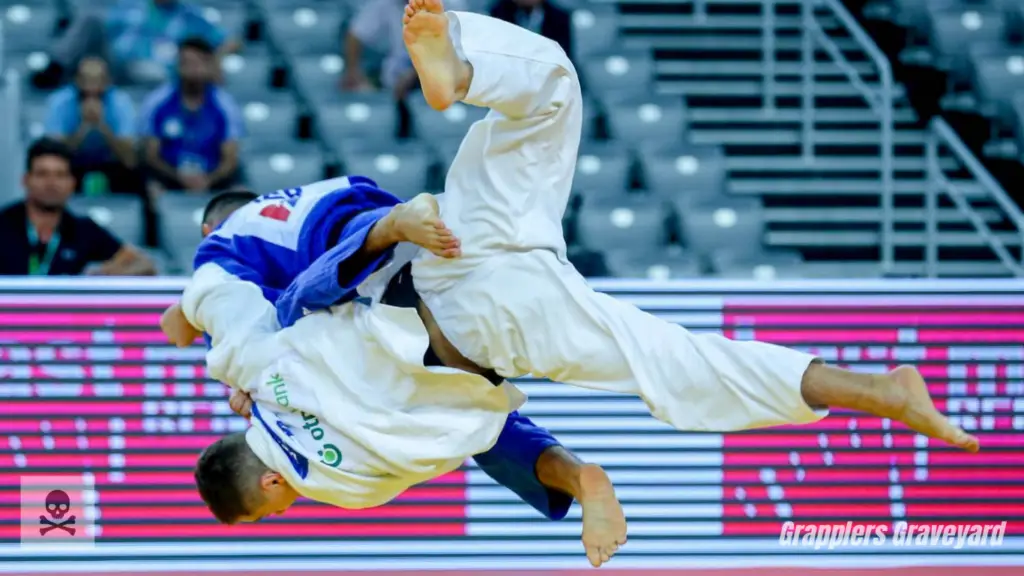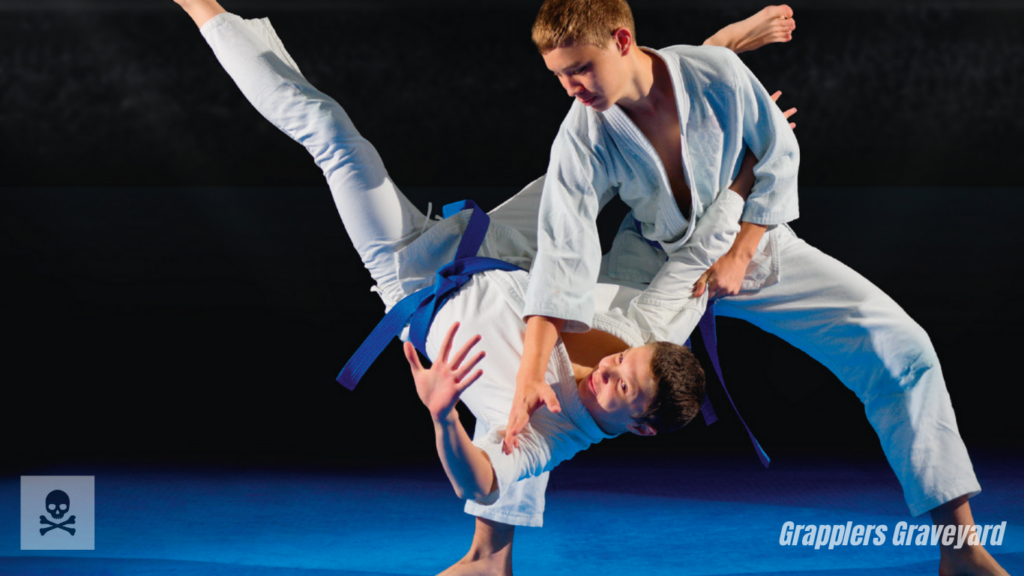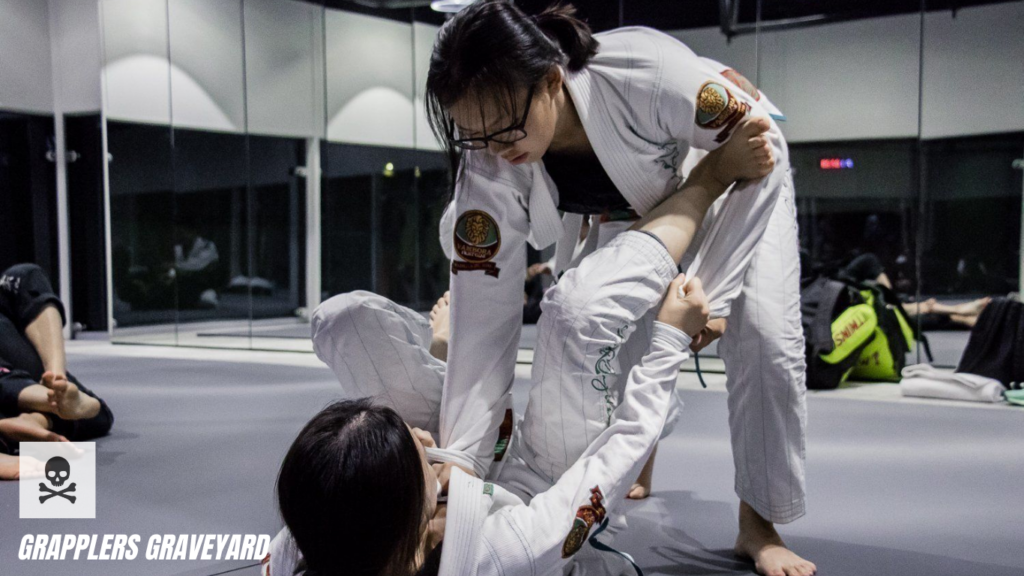
Cameron
Table of Contents
Judo and Jiu-jitsu are both grappling-based fighting styles that are widely popular around the world. Arguably, these are the two most famous grappling martial arts due to their popularity in the Olympics and the Rise of organizations like the UFC. Judo and BJJ are similar in the sense that the fights will clinch with opponents, work for takedowns, and submit their competition. In this article, we will take a further look at Judo vs. Jiu Jitsu.
Judo vs. Jiu-Jitsu: Key Differences
Judo and Brazilian jiu-jitsu are two of the more famous grappling arts in martial arts. BJJ and Judo are arts that can be used for self-defense purposes and have many things in common with one another when looking on the outside.
But as we dive deeper into the two martial arts, we find that there are key differences that separate the art forms in a way that most novice martial artists would not pick up.
To begin Judo is a martial art that primarily focuses on throwing techniques and stand-up game. The goal of a Judoka in competition or any match is to successfully throw your opponent on their back in a forceful manner. This process wins you a match, gives the person who did the action a full point and has a name called an ippon.
Brazilian jiu-jitsu is entirely different in its approach to how matches are won. Like Judo, BJJ is a grappling-based martial art but primarily focuses on grappling, ground techniques, and finding the optimal solution to get your opponent to submit to your techniques.
BJJ and Judo share some similarities in regard to the techniques that are present in the sport but for now let’s dive further into what separates the two martial arts by looking at the differences in their rules and scoring systems.
Just What You Need. We designed the Sanabul Essential Jiu-Jitsu Gi to set a high bar for what you can expect from a BJJ gi whether this is your first Jiu Jitsu gi or an addition to your current line up. Quality construction, clean design, and incredible value make this Brazilian Jiu Jitsu gi the #1 Best Seller in the industry

Scoring System: Judo
The rules and regulations of Judo are governed by a federation known as the IJF (International Judo Federation). Majority of the rules for competitions are fostered by this group and regularly updated when the time is needed.
In Judo competition there are five different ways to secure a victory.
- Throw an opponent with considerable force and speed leading to the opponent’s back hitting the ground
- Pin and hold your opponent to the ground for 20 seconds
- Chokes
- Arm and Joint Locks
- Referees Decision
Judokas win points through a system called waza-ari this is:
- When you throw an opponent on their back but not enough force
- Holding an opponent down for 10 – 19 seconds
Scoring System: Jiu-Jitsu
In Brazilian Jiu-jitsu the goal it to get your opponent to submit and tap out. Points are an effective way to win the match and these are the common objectives of scoring:
- 2 Points are scored for a takedown
- 2 points are scored for a sweep
- 3 points are scored for passing an opponent’s guard
- 4 points are scored if you get into a mounted position
- 2 points are scored if you get a knee-on-belly
- 4 points are scored if you get control of the back (with hooks)
If someone taps out the match is over. BJJ has many more submission techniques than Judo, including leg locks, chokes, arm bars, etc.
Find the top-rated BJJ Gi's here. Helpful information on what to look for, how to find the best gi, and which brands suit you best based on your budget!

Rules: Judo
Judo and jiu-jitsu share many similarities although they do have some distinct differences especially when it comes to progression. As a beginner in both martial arts, you will start out with a white belt and work your way up to a black belt.
In Judo, there are a higher number of belts that follow this order: white, yellow, orange, green, blue, brown, and black.
The rules and the scoring system of judo go hand and hand. To win matches you must successfully get your opponent of their back in a forceful manner or dominate them and control positions.
Rules: Brazilian Jiu-Jitsu
BJJ techniques and rulesets are different than what you will find in Judo. While the progression system is the same you will notice that in BJJ there are fewer belts when compared to Judo.
Typically, Judokas progress through belts by demonstrating a specific set of techniques but it is important to note that the rules of progression depends on the Judo clubs instructor. This is not necessarily the case of how progress is made or shown in a BJJ club.
Competition rules and regulations for BJJ are set by the Internation Brazilian Jiu-Jitsu Federation (IBJJF). A BJJ practitioner that finds themselves competing will also find themselves very familiar with the competition rules that is in place by the IBJJF.
Depending on the competition one finds themselves competing in the ruleset will change. For example, if you are competing in ADCC, JJWL, or IBJJF tournaments the rules will vary very slightly but most things are the same. It is important to read up on exactly what is allowed and what is not allowed when you decide to compete.
Similarities: Judo and Jiu Jitsu
After looking at the differences of the two grappling-based martial arts, it is much easier to see the similarities that the two have.
It is very common for Judokas and practitioners of BJJ to be well-trained in both martial arts because in a lot of ways the two complement each other. Brazilian Jiu-jitsu mixed with Judo and wrestling makes you a formidable opponent to anyone. Being well-rounded in the art of taking people to the floor and being able to control any situation is an underrated skill.
We know plenty of people we personally train with that do this and are leaps and bounds ahead of those around them.

Uniforms
Both in BJJ and Judo you will find people wearing traditional kimonos known as a Gi. The Judo Gi usually only comes in one color, white, and is slightly less durable when compared to the BJJ gi which was built to withstand a lot more action.
Find the top-rated BJJ Gi's here. Helpful information on what to look for, how to find the best gi, and which brands suit you best based on your budget!
Judo vs Brazilian Jiu-Jitsu: What is the Better Martial Art?
This may seem like a silly question to ask but if you are looking to get into martial arts and start your journey, it is valid. Many people in the community of martial arts will go online and give you a million reasons why their martial art is the best or why other martial arts would not work in a “real-world situation”.
We are not here to spew out nonsense like this.
The best martial art to choose is usually one that fits your budget and where you are in your journey. We have done kickboxing and practice BJJ regularly at this point and we firmly believe that BJJ is far superior to anything we have seen.
Good martial arts are street tested and proven over time and nothing to date can really hold a candle to what Brazilian jiu-jitsu has been able to do. We are not the only person who holds this line of thinking and are joined by the likes of Joe Rogan in our opinion.
But, if you are serious about training it is always good to take on multiple disciplines because each one has something to offer… except karate, don’t do karate.
Judo vs Brazilian Jiu-Jitsu For Self Defense
One of the main reasons people get into martial arts, to begin with, is that they want to have some form of self-defense training under their belt. It is common for people that join the community to start for this reason.
Judo For Self Defense
Clearly, the focuses of the two martial arts are completely different. Judoka like many BJJ practitioners trains in multiple martial arts to hone their skills. Being that Judo is an Olympic sport it should not go unnoticed that Judo is much more widely practiced than Brazilian Jiu-Jitsu (for now).
Judokas’ main objective when competing against someone is to get them on their back with a flashy, unpredictable takedown or throw. The goal is to unsettle your opponent rather than overcome them.
In Judo, you are in the standing position almost all the time unless you find yourself losing the match in which case you are on your back. Judo is a good way to work on your stand-up game (without adding striking to the mix) and teaches its practitioners how to get someone off-balance and to the ground effectively. For this reason, many believe it is a solid choice when it comes to using martial arts for self-defense purposes.
The likelihood that you find yourself in any kind of altercation is very slim to begin with but looking deeper it may be safe to say that Brazilian Jiu-Jitsu is the better of the two for a situation that needs to be handled, let’s examine further.

Brazilian Jiu-Jitsu for Self-Defense
Brazilian Jiu-Jitsu is a grappling-based martial art that mainly focuses on joint locks and ground control over an opponent. Many critics of the sport say that BJJ lacks in its ability to teach its practitioners how to properly strike and lacks in teaching takedowns.
While some of the criticism is valid, we believe these claims are mostly hearsay in today’s world. Most Brazilian Jiu-Jitsu schools teach their students’ wrestling techniques and many who take on the sport, to begin with trained wrestling at some point in their life.
Many situations that call for a breakup or break out of a fight end up on the ground and this is where Brazilian Jiu-jitsu really gets to shine vs Judo.
When you train Brazilain jiu-jitsu you are constantly getting live looks in the form of sparring of someone who is actively resisting you and trying to advance themselves in a position that makes you submit.
While your stand-up game could be lacking a bit if you have never thrown a punch in your life (not many people can attest to this) Brazilian jiu-jitsu has proven to be the most effective martial art.
Find the top-rated BJJ Gi's here. Helpful information on what to look for, how to find the best gi, and which brands suit you best based on your budget!
Can You Learn Judo and BJJ at the Same Time?
Yes, doing Judo and Brazilian jiu-jitsu is advantageous in many ways.
Both martial arts are centered around the same thing: grappling and controlling your opponent.
If you are proficient in both takedowns and having your way while on the ground it is hard to not look at yourself as a tough opponent in competition settings. Be warned though, training multiple martial arts does require commitment and possibly a full-time training schedule.
The Benefits of Cross-Training
If your goal is to get into MMA, cross-training is the most important thing you can do.
What martial art you choose to pursue is 100% up to you but our guess is that you will be training BJJ and maybe good enough in Judo. Every fighter at the highest levels knows and is close to being high-level BJJ, it is a must-know martial art for a fighter in the UFC.
Martial arts has already been proven to get you into excellent shape so cross-training only puts you into a smaller category of humans that can do extraordinary things. If you decide to go down this path it is of utmost importance that you take care of your body because it will take a beating from gym to gym.
Brazilian jiu-jitsu and Judo are two of the most popular grappling-based martial arts that people will take on in their journey. We believe that having the confidence from training in martial arts is something that many more people are waking up to the idea of. Every day we are seeing more people enter the transformative world of martial arts and love seeing discipline grow to what almost seemed destined.
Find the top-rated BJJ Gi's here. Helpful information on what to look for, how to find the best gi, and which brands suit you best based on your budget!
The Best Grappling Arts: Jiu-Jitsu and Judo
It is very easy to see that the two best grappling arts are BJJ and Judo. Implementing Judo into your BJJ game will make you much more effective at getting people to the ground and ultimately controlling a match.
Whether you are training for self-defense purposes or just because you enjoy improving yourself in this way, BJJ and Judo are two of the best grappling arts that any beginner could pick up!


